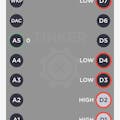I like finished electronic kits and I can focus on the completion here - usually it's nice gadgets for little money from the Far East.I bought myself a music spectrum meter, which brings after connection to a hi-fi system or smartphone the sounds on the 3.5" jack to animate the LED. The rash of the LEDs depends on the beats of the song.
Specs- Operating voltage: 5V USB power supply
- Signal access mode: 3.5 audio line input audio signal
- Installation: DIY welding assembly
- Dimensions: 108 x 70 x 16mm (Length x high x thickness)
- Weight: 130g (including housing); 67g (excluding housing)
I was surprised by the tiny LEDs, called SMD LEDs. These are so tiny that you already need tweezers to arrange them nicely on the PCB. Since there were no sockets for the ICs, the small feet of the IC also had to be soldered carefully here.
On one side of the LED is printed a T inclined to the side, indicating (+) and (-). Compared to the graph:
In my case, sufficient SMD in 3 different colors were available: I have arranged each with 2 tracks in the color change.
I bought quite thin solder for preparation, 0.56mm in diameter.
For soldering I found a nice video, which once again made clear to me how best to proceed.
My wife was so nice and assisted me so that I could focus on the solder joints on the front and my wife individually aligned and handed out the SMDs.
After (1 hour or more for me) the backside: First, I matched the completeness of the components with the PCB. You will find an overview here (PDF or Excel attached), as there is a guide to the kit, but it is a doubly duplicated copy, which in my case was difficult to read.
I had just soldered the speaker for a test: it did not bring the sound over and quickly put it aside.
...with Power
The components I soldered step by step and then came the test: nothing worked. No control light nothing. When I wiggled on the USB port, I could locate a first source of error: not only the 4 side mounts, but also the 5 legs have still been soldered.
...with columns
But instead of all LEDs, the first 3 vertical bars have not jumped: I have the circuit diagram of the IC can identify the responsible legs, which have been applied some solder and there were lit all columns.
...with color
But now I had ran again: an SMD is probably messed up in the assignment: a blue SMD had to be replaced again against a green SMD. With a desoldering pump I have removed the existing solder and removed with the tweezers the SMD. Here he promptly jumped away - not so tragic.
...with time
If you've been practicing, soldering will be quick. Beginners may like to schedule a larger time window. I already had an evening-filling program with my troubleshooting.
Lets see what happendWhen the test was successful, I dedicated myself to the transparent case: in shops you can order this kit with or without housing. Until I had the brown, very suitable protective foil away passed a little time (fingernails presupposed ;-), but even when assembling the individual screws with the mini-nuts, I had to exercise my patience. Fortunately, the case was very well cut.
With the plugging in the sound output of the HiFi system, the sound of the system was lost, because not the boxes were controlled, but the headphone output. Fortunately, there was still a double-output adapter, so that I could still connect a headphone with 3.5".
On the back there is a button: it is not intended for turning on/off, but shows a translation of numbers.
究竟是什么,我不能不幸回答。
Reference



Comments
Please log in or sign up to comment.